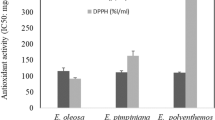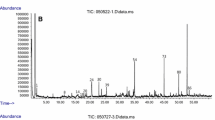Abstract
Screening and identification of phytotoxic volatile compounds were performed using 71 medicinal plant species to find new natural compounds, and the characterization of the promising compound was investigated to understand the mode of action. The volatile compounds from Asarum sieboldii Miq. showed the strongest inhibitory effect on the hypocotyl growth of lettuce seedlings (Lactuca sativa L.cv. Great Lakes 366), followed by those from Schizonepeta tenuifolia Briquet and Zanthoxylum piperitum (L.) DC.. Gas chromatography–mass spectrometry (GC/MS) identified four volatile compounds, α-pinene (2,6,6-trimethylbicyclo[3.1.1]hept-2-ene), β-pinene (6,6-dimethyl-2-methylenebicyclo[3.1.1]heptane), 3-carene (3,7,7-trimethylbicyclo[4.1.0]hept-3-ene), and eucarvone (2,6,6-trimethy-2,4-cycloheptadien-1-one), from A. sieboldii, and three volatile compounds, limonene (1-methyl-4-(1-methylethenyl)-cyclohexene), menthone (5-methyl-2-(propan-2-yl)cyclohexan-1-one), and pulegone (5-methyl-2-propan-2-ylidenecyclohexan-1-one), from S. tenuifolia. Among these volatile compounds, eucarvone, menthone, and pulegone exhibited strong inhibitory effects on both the root and shoot growth of lettuce seedlings. Eucarvone-induced growth inhibition was species-selective. Cell death, the generation of reactive oxygen species (ROS), and lipid peroxidation were induced in susceptible finger millet seedlings by eucarvone treatment, whereas this compound (≤158 μM) did not cause the increase of lipid peroxidation and ROS production in tolerant maize. The results of the present study show that eucarvone can have strong phytotoxic activity, which may be due to ROS overproduction and subsequent oxidative damage in finger millet seedlings.






Similar content being viewed by others
Abbreviations
- DHE:
-
Dihydroethidium
- DMSO:
-
Dimethyl sulfoxide
- DW:
-
Distilled water
- FDA:
-
Fluorescein diacetate
- FID:
-
Flame ionization detector
- GC:
-
Gas chromatography
- GC-MS:
-
Gas chromatography–mass spectrometry
- GR50 :
-
The dose required to cause a 50 % reduction in plant growth
- OH·:
-
Hydroxyl radical
- PI:
-
Propidium iodide
- ROS:
-
Reactive oxygen species
- SOD:
-
Superoxide dismutase
References
Alsaadawi IS, Arif MB, Alrubeana AJ (1985) Allelopathic effects of Citrus aurantim L. II. Isolation, characterization, and biological activities of phytotoxins. J Chem Ecol 11:1527–1534
Asplund RO (1968) Monoterpenes: relationship between structure and inhibition of germination. Phytochemistry 7:1995–1997
Chowhan N, Singh HP, Batish DR, Kaur S, Ahuja N, Kohli RK (2013) β-Pinene inhibited germination and early growth involves membrane peroxidation. Protoplasma 250:691–700
Coleman WK, Lonergan G, Silk P (2001) Potato sprout growth suppression by menthone and neomenthol, volatile oil components of Minthostachys, Satureja, Bystropogon, and Mentha species. Am J Potato Res 78:345–354
Dayan FE, Romagni JG, Tellez MR, Rimando AM, Duke SO (1999) Managing weeds with natural products. Pestic Outlook 5:185–188
Dayan FE, Romagni JG, Duke SO (2000) Investigating the mode of action of natural phytotoxins. J Chem Ecol 26:2079–2094
Duke SO, Abbas HK, Amagasa T, Tanaka T (1996) Phytotoxins of microbial origin with potential for use as herbicides. In: Copping LG (ed) Crop Protection Agents from Nature, Natural Products and Analogues. Royal Society of Chemistry, Cambridge, pp 82–113
Duke SO, Dayan FE, Romagni JG, Rimando AM (2000a) Natural products as sources of herbicides: current status and future trends. Weed Res 40:99–111
Duke SO, Romagni JG, Dayan FE (2000b) Natural products as sources for new mechanisms of herbicidal action. Crop Prot 19:583–589
Fitzhenry A (2005) d-Limonene herbicide. Granted Innovation Patent (Aust.), AU 2005100476 A4 20050818, Aug 18, 2005
Forney LJ, Reddy CA, Tien M, Aust SD (1982) The involvement of hydroxyl radical derived from hydrogen peroxide in lignin degradation by the white rot fungus Phanerochaete chrysosporium. J Biol Chem 257:11455–11462
Fry SC (1998) Oxidative scission of plant cell wall polysaccharides by ascorbate-induced hydroxyl radicals. Biochem J 332:507–515
Fujii Y, Shibuya T, Yasuda T (1990) Survey of Japanese weed and crops for the detection of water-extractable allelopathic chemicals using Richards’ function fitted to lettuce germination test. Weed Res, Jpn 35:362–370 (in Japanese with English summary)
Fujii Y, Parvez SS, Parvez MM, Ohmae Y, Iida O (2003) Screening of 239 medicinal plant species for allelopathic activity using the sandwich method. Weed Biol Manag 3:233–241
Fujii Y, Matsuyama M, Hiradate S, Shimozawa H (2005) Dish pack method: a new bioassay for volatile allelopathy, Proc 4th World Cong Allelopathy. 493–497
Gaff DF, Okong'o-Ogola O (1971) The use of non-permeating pigments for testing the survival of cells. J Exp Bot 22:756–758
Haig T (2008) Allelochemicals in plants. In: Zeng RS, Mallik AU, Luo SM (eds) Allelopathy in sustainable agriculture and forestry. Springer, New York, pp 63–104
Halligan JP (1975) Toxic terpenes from Artemisia californica. Ecology 56:999–1003
Han CM, Pan KW, Wu N, Wang JC, Li W (2008) Allelopathic effect of ginger on seed germination and seedling growth of soybean and chive. Sci Hort 116:330–336
Islam AKMM, Kato-Noguchi H (2013) Plant growth inhibitory activity of medicinal plant Hyptis suaveolens: could allelopathy be a cause? Emir J Food Agric 25:692–701
Kim J, Park IK (2008) Fumigant toxicity of Korean medicinal plant essential oils and components from Asiasarum sieboldi root against Sitophilus oryzae L. Flavour Frag J 23:79–83
Langenheim JH (1994) Higher plant terpenoids: a phytocentric overview of their ecological roles. J Chem Ecol 20:1223–1280
Maffei M, Sacco T (1987) Chemical and morphometrical comparison between two peppermint notomorphs. Planta Med 2:214–216
Mittler R (2002) Oxidative stress, antioxidants and stress tolerance. Trends Plant Sci 7:405–410
Muller WH, Muller CH (1964) Volatile growth inhibitors produced by Salvia species. Bull Torrey Bot Club 91:327–330
Muller CH, Muller WH, Haines BL (1964) Volatile growth inhibitors produced by aromatic shrubs. Science 143:471–473
Nishida N, Tamotsu S, Nagata N, Saito C, Sakai A (2005) Allelopathic effects of volatile monoterpenoids produced by Salvia leucophylla: inhibition of cell proliferation and DNA synthesis in the root apical meristem of Brassica campestris seedlings. J Chem Ecol 31:1187–1203
Oumzil H, Ghoulami S, Rhajaoui M, Ilidrissi A, Fkih-Tetouani S, Faid M, Benjouad A (2002) Antibacterial and antifungal activity of essential oils of Mentha suaveolens. Phytother Res 16:727–731
Pan H, Ouyang T (2011) Comparative analysis of volatile oil extracted from Asarum sieboldii Miq. by distillation and ultrasound-assisted extraction. Shipin Kexue 32:190–193 (in Chinese with English abstract)
Pan J, Zhu M, Chen H (2001) Aluminum-induced cell death in root-tip cells of barley. Environ Exp Bot 46:71–79
Park IK, Kim LS, Choi IH, Lee YS, Shin SC (2006) Fumigant activity of plant essential oils and components from Schizonepeta tenuifolia against Lycoriella ingenua (Diptera: Sciaridae). J Econ Entomol 99:1717–1721
Pompella A, Maellaro E, Casini AF, Comporti M (1987) Histochemical detection of lipid peroxidation in the liver of bromobenzene-poisoned mice. Am J Pathol 129:295–301
Romagni JG, Allen SN, Dayan FE (2000) Allelopathic effects of volatile cineoles on two weedy plant species. J Chem Ecol 26:303–313
Schweikert C, Liszkay A, Schopfer P (2000) Scission of polysaccharides and peroxidase-generated hydroxyl radicals. Phytochemistry 53:565–570
Sekine T, Sugano M, Majid A, Fujii Y (2007) Antifungal effects of volatile compounds from Black Zira (Bunium persicum) and other spices and herbs. J Chem Ecol 33:2123–2132
Singh HP, Batish DR, Kaur S, Ramezani H, Kohli RK (2002) Comparative phytotoxicity of four monoterpenes against Cassia occidentalis. Ann Appl Biol 141:111–116
Singh HP, Batish DR, Kaur S, Arora K, Kohli RK (2006) α-Pinene inhibits growth and induces oxidative stress in roots. Ann Bot 98:1261–1269
Singh HP, Kaur S, Mittal S, Batish DR, Kohli RK (2009) Essential oil of Artemisia scoparia inhibits plant growth by generating reactive oxygen species and causing oxidative damage. J Chem Ecol 35:154–162
Sodaeizadeh H, Rafieiolhossaini M, Havlik J, Damme PV (2009) Allelopathic activity of different plant parts of Peganum harmala L. and identification of their growth inhibitors substances. Plant Growth Regul 59:227–236
Sunohara Y, Matsumoto H (2008) Quinclorac-induced cell death is accompanied by generation of reactive oxygen species in maize root tissue. Phytochemistry 69:2312–2319
Sunohara Y, Shirai S, Yamazaki H, Matsumoto H (2011) Involvement of antioxidant capacity in quinclorac tolerance in Eleusine indica. Environ Exp Bot 74:74–81
Tamás L, Šimonovičová M, Huttová J, Mistrík I (2004) Aluminium stimulated hydrogen peroxide production of germinating barley seeds. Environ Exp Bot 51:281–288
Umebayashi Y, Miyamoto Y, Wakita M, Kobayashi A, Nishisaka T (2003) Elevation of plasma membrane permeability on laser irradiation of extracellular latex particles. J Biochem 134:219–224
Vaughn SF, Spencer GF (1993) Volatile monoterpenes as potential parent structures for new herbicides. Weed Sci 41:114–119
Vaughn SF, Spencer GF (1996) Synthesis and herbicidal activity of modified monoterpenes structurally similar to cimmethylin. Weed Sci 44:7–11
Vokou D, Douvli P, Blionis GJ, Halley JM (2003) Effects of monoterpenoid, acting alone or in pairs, on seed germination and subsequent seedling growth. J Chem Ecol 29:2281–2301
Walling C (1975) Fenton’s reagent revisited. Acc Chem Res 8:125–131
Yamamoto Y, Kobayashi Y, Matsumoto H (2001) Lipid peroxidation is an early symptom triggered by aluminum, but not the primary cause of elongation inhibition in pear roots. Plant Physiol 125:199–208
Yamamoto Y, Kobayashi Y, Devi SR, Rikiishi S, Matsumoto H (2002) Aluminum toxicity is associated with mitochondrial dysfunction and the production of reactive oxygen species in plant cells. Plant Physiol 128:63–72
Zhao H, Kalivendi S, Zhang H, Joseph J, Nithipatikom K, Vasquez-Vivar J, Kalyanaraman B (2003) Superoxide reacts with hydroethidine but forms a fluorescent product that is distinctly different from ethidium: potential implications in intracellular fluorescence detection of superoxide. Free Radic Biol Med 34:1359–1368
Zunino MP, Zygadlo JA (2004) Effect of monoterpenes on lipid oxidation in maize. Planta 219:303–309
Acknowledgments
We would like to thank Dr. Y. Fujii (Tokyo University of Agriculture and Technology, Japan) for his helpful suggestions. This work was partially supported by a Grant-in-Aid for Scientific Research (C) (No. 25450068) from the Japan Society for the Promotion of Science.
Conflict of interest
The authors declare that they have no conflict of interest.
Author information
Authors and Affiliations
Corresponding author
Additional information
Handling Editor: Peter Nick
Yukari Sunohara and Yohei Baba contributed equally to this work.
Electronic supplementary material
Below is the link to the electronic supplementary material.
ESM 1
(DOCX 277 kb)
Rights and permissions
About this article
Cite this article
Sunohara, Y., Baba, Y., Matsuyama, S. et al. Screening and identification of phytotoxic volatile compounds in medicinal plants and characterizations of a selected compound, eucarvone. Protoplasma 252, 1047–1059 (2015). https://doi.org/10.1007/s00709-014-0739-4
Received:
Accepted:
Published:
Issue Date:
DOI: https://doi.org/10.1007/s00709-014-0739-4




